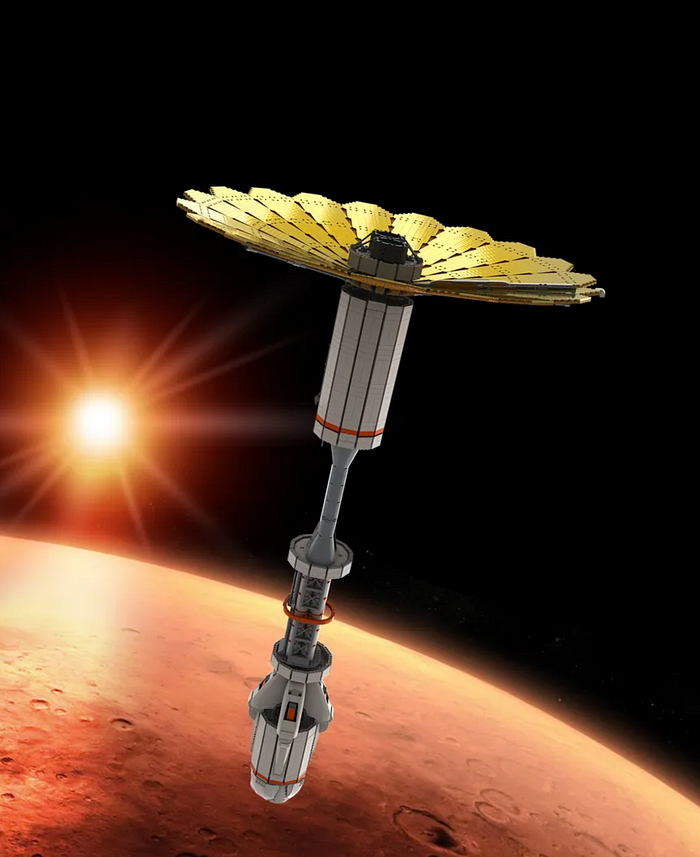
On the occasion of the paperback edition of my book “Interstellar” coming out in a week, I wondered how humanity might save energy in reaching interstellar space?
As is often the case, we can learn from nature by adopting the way that the dandelion flower saves energy as it strays away from its birth place. The dandelion seeds are carried by the wind and replicate the genetic information of the flower on distant fertile grounds.
In the same vein, all we need to do in order for our seeds to be carried to interstellar space is to boost our `dandelion spacecraft’ — hereafter labeled as `d-craft,’ from 30 kilometers per second — the speed at which the Earth moves around the Sun, to 42 kilometers per second — the escape speed from the solar system. The escape speed from planet Earth is 11 kilometers per second. On top of that, we just need an extra 12 kilometers per second in the direction of the Earth’s motion around the Sun in order to reach 42 kilometers per second relative to the Sun. This task is feasible with existing rocket technology.
Once our d-craft reaches the outer edge of the Oort cloud, it will be ripped apart from the solar system by the tidal forces of passing stars or the Milky-Way as a whole. It will later be carried for-free around the Milky-Way disk at the local circular velocity of about 233 kilometers per second, plus the velocity of the Sun relative to the Local Standard of Rest of about 17 kilometers per second. As I had calculated in a new paper with my Harvard student, Shokhruz Kakharov, this motion would carry the d-craft over a billion years to the opposite side of the Milky-Way galaxy relative to the Local Standard of Rest.
This is the energy-efficient way of spreading interstellar seeds at any time. But if we wish our d-craft to spread only after the Sun will die, we can park them in the solar system at a distance which is 10 times closer to the Sun than the outer edge of the Oort cloud. Once the Sun will evolve to a red giant and lose 40% of its mass to become a white dwarf, the reduced gravitational pull of the remnant will cause these d-craft to expand their orbital radius by a factor of ten and reach the edge of the solar system. The d-craft could include an obituary about Earth which will be consumed earlier by the red giant envelope. This automatic timer will be activated once the Sun dies. The message carried by the d-craft could read: “The Sun is dead. Life on Earth was fun while it lasted.”
If extraterrestrial civilizations follow the same objectives, their d-craft would be parked at the periphery of their Oort clouds. If these d-craft were designed to transmit communication signals to their senders, SETI searches from Earth could detect these transmissions when both the parent planet and the d-craft transmission beam line-up with our line-of-sight.
The saving in propulsion energy is much greater near massive stars that explode as supernovae. First, the explosive energy carried by the supernova radiation or the ejecta could propel d-craft to more than a percent of the speed of light. An advanced civilization could park d-craft within the pre-explosion planetary system at a distance where the explosion will not destroy them. Interestingly, the Vela supernova remnant shows peculiar X-ray emission from dense `bullet-like’ clumps of unknown origin, which I tried to explain thirty years ago in a paper with Fred Rasio and Jacob Shaham.
Of course, one could send d-craft to privileged locations, such as the vicinity of a binary star system like our nearest neighbors Alpha-Centauri A & B, where they can be propelled to high speeds by these systems acting as gravitational slingshots. The best prospects are offered by pairs of black holes, which can slingshot d-craft gravitationally up to the speed of light, as I had shown in two papers (here and here) with my former postdoc, James Guillochon.
All in all, d-craft offer the cheapest rides for interstellar travel and so they might be the most abundant technological probes that the Galileo Project would find. If any are discovered as anomalous interstellar objects, it should be possible to trace back their origin based on their velocity and direction of motion, as described in my recent paper with Shokhruz.
By now, the Sun has traveled 23 times around the Milky-Way galaxy since it was born 4.6 billion years ago. The tidal force exerted by the Sun could have stolen objects from the Oort clouds around a hundred thousand stars which passed through the solar system during that time. If d-craft were parked there, some of them might be currently trapped in the solar system.
By finding multiple alien d-craft, we can unravel the long history of intelligent life in the Milky-Way galaxy. As with any other study of history, the lessons learned could inspire us to create a better future for ourselves than the past of all of those who inhabited the Milky-Way before us.
ABOUT THE AUTHOR

Avi Loeb is the head of the Galileo Project, founding director of Harvard University’s — Black Hole Initiative, director of the Institute for Theory and Computation at the Harvard-Smithsonian Center for Astrophysics, and the former chair of the astronomy department at Harvard University (2011–2020). He is a former member of the President’s Council of Advisors on Science and Technology and a former chair of the Board on Physics and Astronomy of the National Academies. He is the bestselling author of “Extraterrestrial: The First Sign of Intelligent Life Beyond Earth” and a co-author of the textbook “Life in the Cosmos”, both published in 2021. His new book, titled “Interstellar”, was published in August 2023.
